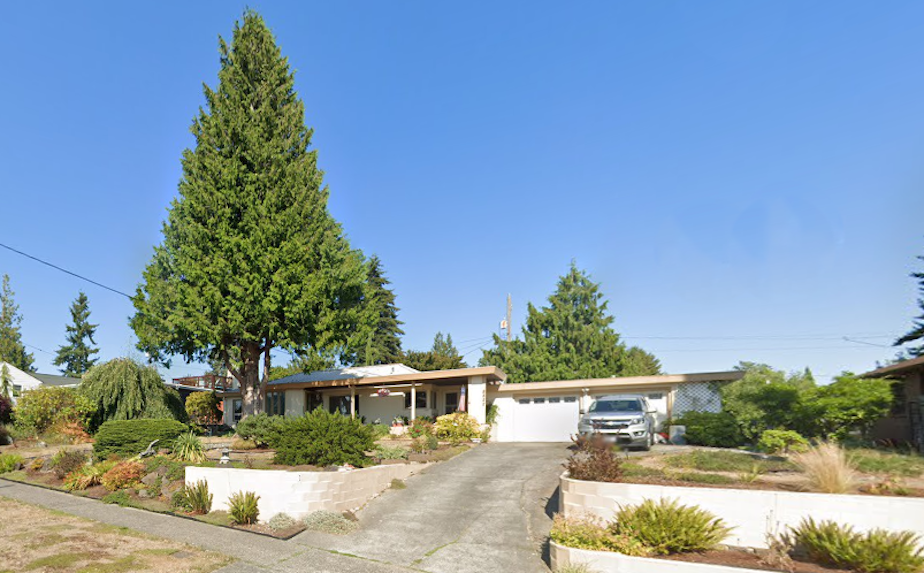Seattle passed a tree protection law last year. So why did a 'protected' cedar get the ax?

On Tuesday, a 60-foot cedar tree in West Seattle was cut down to make way for a six-home development project, despite being designated by the city as "protected" from home demolition. Local environmental advocates say the removal of the tree, which they called “Henry,” demonstrates that the city’s tree protection ordinance doesn’t extend far enough.
Seattle enacted a new tree protection ordinance last summer, following an outcry over a developer’s plans to chop down an 80-foot tribally significant tree called Luma in Wedgwood. Under the ordinance, a protective radius is drawn around a tree based on its size, which determines how much of the area around it can be developed. But because of Henry’s size, the lot around it couldn’t be developed unless the tree was cut down. Otherwise, developers would have been in violation of the ordinance — an outcome that is counterproductive, said Sandy Shettler, an activist with Tree Action Seattle.
RELATED: New deal saves Seattle's celebrity tree, 'Luma'
“Up until recently we were losing trees because we had a good law with no enforcement,” she said. “But then they changed the law entirely and made it a bad law. So now we have a bad law and bad enforcement, so there's really nothing that can be saved.”
The rules passed last year limit the ability to remove trees from properties not being redeveloped. They also require the replacement of cut-down trees that are 12 inches or greater in diameter, or a monetary donation to the One Seattle Tree Fund that is equal in value to a removed tree. In the latter scenario, the city plants a replacement tree.
Sponsored
That doesn’t entirely solve the problem for Shettler.
“Trees do not produce any of the benefits we need at scale until they are fairly mature — takes decades,” she said. Those benefits include the cooling effect of tree canopy, improved air quality, and wildlife diversity.
A 2021 city report cited a 1.7% loss of tree canopy across Seattle between 2016 and 2021, with neighborhoods most impacted by racial and economic inequities bearing the brunt of that loss.
A draft report shared with KUOW by Birds Connect Seattle projects that over 200 acres of tree canopy will be lost to development in those same neighborhoods. That contradictory outlook is troubling, said Joshua Morris, Birds Connect Seattle’s urban conservation manager and the report’s author.
“Planning [development] around the preservation of these trees hasn't occurred at a really thoughtful or analytical level,” Morris said.
RELATED: Tree-sitter seeks to save 'exceptional tree' in Seattle
For her part, Shettler said she doesn’t fault the Department of Construction and Inspections, which is in charge of enforcing the tree protection ordinance, for striving to build. But that the department oversees tree protection is in conflict with its development goals, she said, adding that the city should create a new office for that task.
Department of Construction and Inspections spokesperson Bryan Stevens said in an email that the tree protection ordinance “strikes a balance by protecting and growing a healthy tree canopy citywide and addressing inequities in tree canopy distribution…while supporting housing production needed during a homelessness and housing crisis.”
Seattle City Council member Maritza Rivera told KUOW she agrees that a new tree protection ordinance was a good place to start, but said “it is clear that we must do more to protect the tree canopy in our city, particularly as we manage climate change.”
She said she wants to collaborate with developers and housing providers to ensure trees are preserved as projects move forward.
Seattle’s Office of Sustainability and Environment is slated to complete a citywide assessment of tree canopy equity by the end of the year, which will look at where tree planting would be most beneficial.
Correction notice, Thursday, 4/11/2024: An earlier version of this story incorrectly stated the percentage of tree canopy loss in Seattle between 2016 and 2021. This report has been updated to reflect the correct data.




